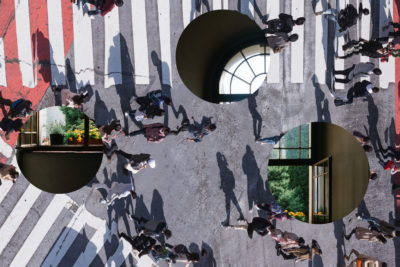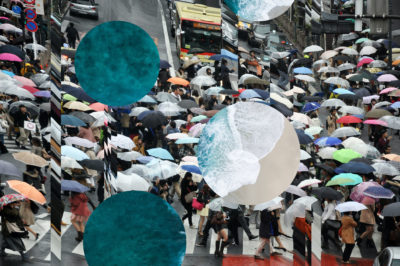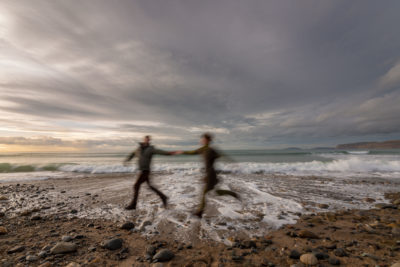Read this article in the limited edition print version: order a copy here.
Dancer, theologian and Gestalt therapist are words often used to introduce Claire Henderson Davis, depending on the ‘hat’ she’s wearing. But as we talk on a Friday morning in early September, I realise this is just the tip of the iceberg.
While studying theology at The University of Edinburgh, Claire began training in dance and choreography, in tandem with her PhD. From 2015-2018, Claire held the fascinating position of Contemporary Performance Artist & Theologian in Residence at Chester Cathedral, supported in part by the Passionists.
She is also the author of After the Church: Divine Encounter in a Sexual Age, an autobiographical re-imagining of the Christian tradition in contemporary language. More recently, she has been working as a police chaplain, and is just completing her accreditation as a Gestalt Therapist. On top of all this, she is an environmental activist and passionate advocate for reconciling the church and the embodied self.
We spoke at length about All Creation Waits, a dance theatre production which Claire directed and performed in 2019 (in collaboration with Ian Bush, Fraser Patterson, Malcolm Guide and Gary Lloyd)—and which toured the UK last autumn as a film. All Creation Waits is a contemporary imagining of St Francis and St Clare, coming to terms with the need to leave their existing lives in addressing our environmental emergency.

Q Claire, can you tell us about the project and about the motivations behind such a work?
A The Third Order Anglican Franciscans were looking to somehow engage the charism of St. Francis with the contemporary world, and they asked me whether I would consider making a piece around this idea. Initially I wasn’t interested; I thought there’s too much scope for sentimentality here, but I said I would think about it. Around this same time I was finishing my residency at Chester Cathedral, and I went and lived for a year in this little village called Llanrhaeadr-ym-Mochnant in north Wales, in a housing cooperative.
Steve Jones, from Sector 39, who founded the cooperative, is an expert in permaculture. So, this is the environment I found myself in; I was full of permaculture ideas, spending a lot of time taking long walks in the hills, and thinking about Francis in that context. So it started to come to mind how I might approach such a project, and how to do it in connection with climate change.
It started with the idea of Francis and Clare, and their relationship; not as a retelling of the historical story, but as a symbolic re-imagining. Francis has withdrawn from the world, and Clare comes to join him. Clare, in the piece, comes in on her high heels, very unbalanced, tottering around, and there’s an exhaustion in her.
I felt like Clare was the symbol of the earth, a symbol of nature—what we’re doing to nature, that connection between the feminine and the earth. That felt very symbolic of what’s going on in our culture, with the erasure of the feminine voice or the body, particularly in Christianity.
So Francis, having withdrawn from the world, is interrupted when Clare arrives, which is that thing that happens to us, isn’t it? What do we do when we are interrupted? And so they have to share the space, they have to make a relationship with each other. Francis really has to face his own violence towards the earth, which leads them towards a place of finding connection, and then of going out to create change.
Q The relationship portrayed between St Clare and St Francis, in this re imagined contemporary setting, develops slowly throughout the performance. Through letters, shared radio listening and mutual readings of Laudato Si the two characters are changed in these everyday moments of reflection and interaction together.
As a choreographer and dancer what was it like to work on a piece which embraces slowness and the contemplation of the everyday?
A The text came first, and I knew I was going to ask Malcolm Guite to write the text. But before he wrote the script, we went on quite a wild trip together. Fraser and I drove Malcolm from Manchester out to the Aberdaron, where the opening film was made, and we showed him all the places that we wanted to use. I had gone to Aberdaron by myself in 2011, and I knew that’s where we were going to set this, because the story is about Francis restoring the church outside the city.
Once Malcolm had written the text, we went down to London to work with a voice coach on how to speak the text. Composer Gary Lloyd then recorded the text with us, and used it to create a soundscape with text, music and sounds of nature. With that recording of the text, we went into the studio to work on the physical. Because of the text, the movement had to be quite contemplative. It had to be in a relationship with the words. I think that’s why there’s a kind of slowness in it, in order to create space. There has to be space for the words to be heard.
There’s almost like an element of movement poetry in it, it’s not ‘dancey’ dance. It’s physical theatre that’s creating the relationship with the text.

Q The videoed work has recently been on tour across the UK, an adaptation which had to be made to the original live tour due to the Covid 19 pandemic. What was it like having to adapt the work under the circumstances and what has engagement been like from audiences?
A I mean, it was kind of the piece that broke me! It was such a disaster in the sense that, first we had the trauma of Fraser leaving the piece, which is its own story, and so we were re-rehearsing it quite at the last minute with Bysh. We then premiered in Salford Cathedral, and then, you know, the pandemic and everything was cancelled.
So, what do we do with this? What do we do with the funding? Finally we decided to make the film, and I really feel glad about that.
Then I had this idea of launching it for Cop 26. In theory, it was a good idea, but in a sense it suffered from the competition of Cop 26 rather than being supported by it—and then in the lead up to it, I got pneumonia, and I couldn’t go on the tour. So in some ways, it was a total disaster, but it got a good audience in Chester, and I’ve had some lovely correspondence from people who’ve really been moved by it.
The redeeming factor is the film was made. In some ways, it feels like it may not have got its final outing yet.
Q In a recent open letter to Pope Francis you draw parallels between the harm inflicted on our common home, of this earth, and the relationship of the church to women and the feminine. Can you tell us more about your personal heart and priestly calling to actively work towards repair and reconciliation in both of these areas?
A Right at the heart of Christianity is the idea of incarnation, of the word becoming flesh. Jesus is the word who becomes flesh. But I think, incarnation is also a description of a process at the heart of human life, that connects the body and the mind.
For example, any creative idea begins as something in the imagination, and then we have to engage with the material world in order to bring that about. As we engage with the material world, further ideas come that shape our sense of the word. But we’re in a culture where there’s a profound distortion within that relationship, between word and flesh, that has come out of the church.
Let’s say, in an archetypal sense, the word is masculine and the flesh is feminine. What we have is a culture in the church where the word has dominated the flesh. The word imposes itself; the material world is being used and abused—rather than the material world having its own integrity, its own limits that need to be respected, its own shape. For example, in a fertile relationship between word and flesh, there’s an open-endedness about the word. As the word engages with the flesh, then the word learns new things, as the flesh takes form. The word changes, and there’s a reciprocal relationship.
Christianity, in that sense, has a lot to answer for. In its rejection of the flesh as something that must be controlled, overcome, and repressed, it has not learned the process of incarnation. So what we have left is just the word. The word which is simply barren, because it has no skilled relationship to the material world.
What you have, then, is a culture in which people are looking for that connection in other ways: through yoga, through other kinds of practices that are drawn from other traditions, because there’s a lack of skill in this area within the Christian tradition.
“Kneeling, for example, shapes the body into a form of humility. So what kind of body is the Christian tradition currently shaping?”
What I’m trying to do is to develop a living practice of incarnation in my work, that develops skills in relation to the material world, to the body, to feeling. All of my work has been about developing those skills, through psychotherapy, through dance, through breathing, meditation and yoga.
There’s a need to heal that relationship, and that’s what I’m doing in relation to Christianity. I’m not willing to abandon the Christian tradition, because our culture is deeply formed in this tradition; there’s a need to heal that relationship.
Q Liturgical practices, repetition and shared public acts seem to be themes that are important within your wider body of work. Focusing on humanity’s current relationship with the environment and the divine feminine, what new shared public acts to do think the church needs to embrace at this time?
A My interest has always been in liturgy. I did my PhD looking at liturgy, using research in anthropology on ritual. This approach to ritual asks not ‘what does it mean?’, but ‘what kind of body does it form?’ Kneeling, for example: kneeling shapes the body into a form of humility. So the question I was asking was ‘what kind of body is the Christian tradition currently shaping?’
I was looking particularly at this book called, In Breaking of Bread: The Eucharist and Ritual by P. J. Fitzpatrick. He was writing about what happened in the Second Vatican Council: you had a democratisation of the liturgy, where it became participatory, but no parallel change happened in the power structure of the church.
“Incarnation is a description of a process at the heart of human life, that connects the body and the mind.”
So he argued that the liturgy, in this expression, became a form of propaganda, because it wasn’t a true expression of the corporate life of the church. It was giving a show of democracy, but there was no real democracy within the church and that was why it failed, because those who wanted the tradition to remain the same, rejected the democratisation; and those who wanted to change saw there was the democratisation of the liturgy, but not of the church. No-one was satisfied, and I think that that remains, in a way, a central problem in the church.
Liturgy, then, is no longer seen as something that the church is really offering to the public; it’s become like a private language for Christians who go to church. The church has started to use a kind of discursive, rational language to talk with others, outside of the church, so they talk about social justice and things like that, but in that, they’ve lost an embodied language. I’m interested in how we create a public, embodied language for the church.
Q Lastly, what’s next for you?
A I am exploring ministry in the Anglican Church. I’m still working in psychotherapy, and want to keep connected to that. In terms of my creative work, I want to explore djembe drumming; I’m not sure why, but I feel this is my way into whatever happens next on that liturgical level.
To watch All Creation Waits or for more information about Claire’s practice please visit www.clairehendersondavis.com. After the Church: Divine Encounter in a Sexual Age can be purchased from all good bookshops.
Related Stories

Experiences of Passionist prayer, pt. 3: Joanne Crompton
How do we pray? What role does prayer take in our lives? We asked three people pursuing a Passionist spirituality how their sense of prayer has changed over time.
Jul 05 2023

Experiences of Passionist prayer, pt. 2: Bishop William Kenney
How do we pray? What role does prayer take in our lives? We asked three people pursuing a Passionist spirituality how their sense of prayer has changed over time.
Jun 24 2023

Experiences of Passionist prayer, pt. 1: Michael O’Halloran
How do we pray? What role does prayer take in our lives? We asked three people pursuing a Passionist spirituality how their sense of prayer has changed over time.
Jun 18 2023




